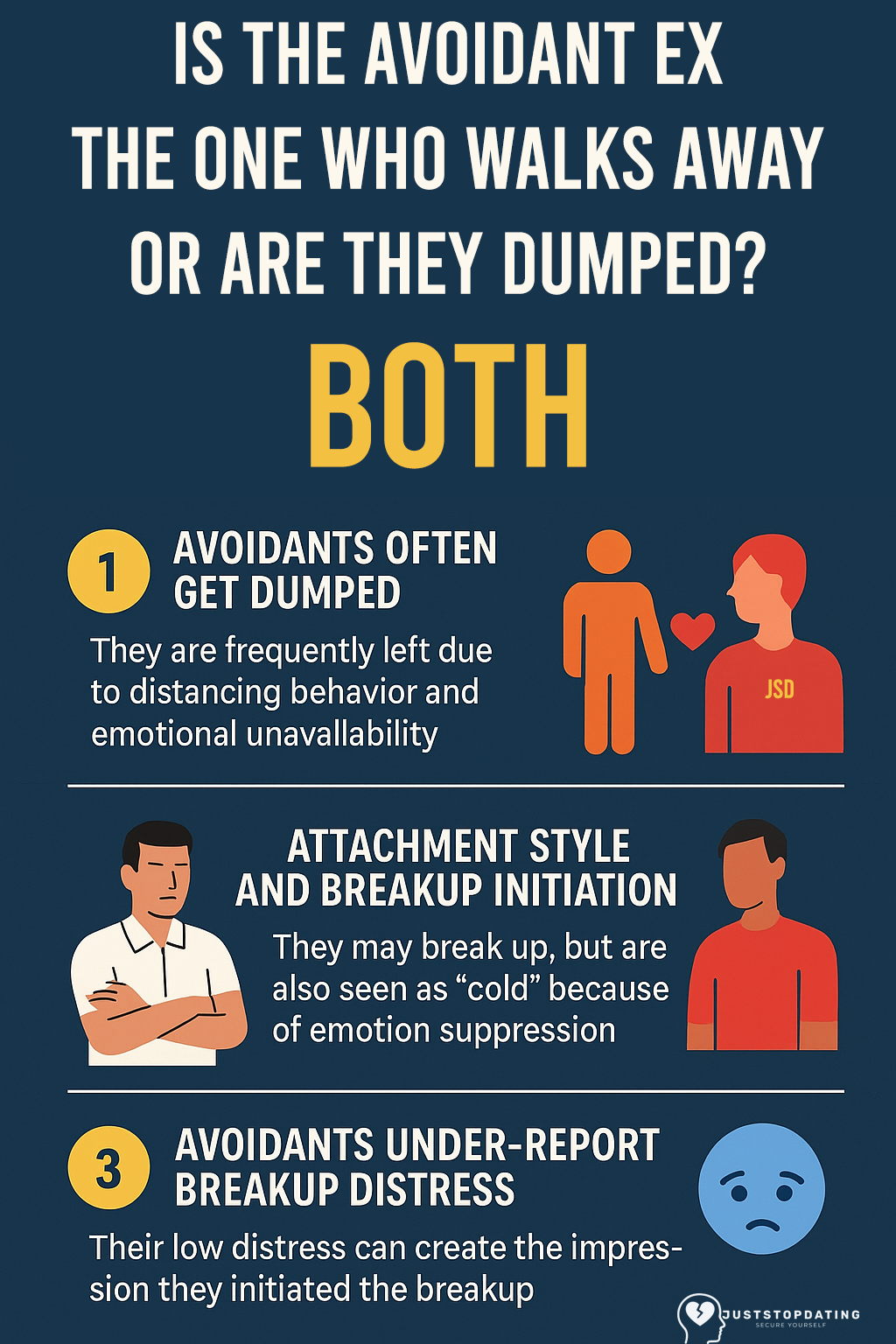One of the fastest ways to be dumped as an avoidant is by dating someone while fearing commitment. The relationship will move along and as the avoidant, you’ll hide that fear in noticeable habits, delayed timing, and by tensing up when your partner wants to be close and you can’t lower your shoulders and relax. Their love feels safe from a distance, so you get dumped. Every time. That sounds hella familiar, right? Let’s talk about it.
1. Make the Avoidant Attachment Style Your Entire Personality
Avoidant attachment, typically forming in early childhood (around 1-5 years old), develops when a child’s emotional needs are not met with consistent, responsive care. Instead of learning that closeness is safe and rewarding, children may experience rejection, indifference, or inconsistent care, leading them to suppress their emotional needs and avoid seeking closeness. This can manifest as a strong preference for independence and a tendency to avoid social and emotional intimacy.
So, individuals who become avoidant adapt by downplaying their emotions and relying only on themselves. That survival strategy hardens them and the mantra becomes: stay distant, stay in control. When avoidant individuals begin dating, relationships progress into uncomfortable territory and they pull away from their partner in a manner that looks like they fear commitment.
If or when more relationships end, it’s a short trip to turning that pattern into a personality. If you’re familiar with avoidant individuals who are friends or partners, they stop saying “I avoid relationships” and start saying “I am avoidant.” When you’re dating, pay very close attention to the language people use about relationships (even me). Avoidant individuals love a good joke and deflection to justify detachment and romantic unreliability. Let’s be real, fearing commitment is not really funny when it’s something you genuinely want but you’re afraid of it.
2. Cycle Through Feelings of Love, Fear, and Emotional Withdrawal
As the avoidant ex, fearing commitment often sets off a repeating cycle: intense feelings of love, followed by fear/anxiety, then sudden emotional withdrawal. Relationships start with genuine connection in which you’re drawn in, captivated, maybe even hopeful. But as the relationship becomes more serious and discussions where you define the relationship initiate, expectations of your upgraded role start to build. Now, there is pressure and more opportunity to ruin the relationship. This is where emotional deactivation or “emotional shutdown” begins.
Emotional shutdown in avoidantly attached people usually starts when things begin to feel serious when the relationship gets more involved, and the other person starts asking for more time, attention, or honesty. We previously shared research that shows it takes a maximum of 0.5 seconds for an avoidant partner to emotionally shut down when you ask them to open up. Emotional deactivation is how avoidants attempt to stay in control and avoid what feels like emotional pressure.
The more a partner pushes for connection, the more the avoidant partner backs off. It’s not about not caring, it’s about fearing commitment and needing distance to feel safe (Millings et al., 2020). According to According to Dr. Dirk W Eilert and Dr. Anna Buchheim of University of Innsbruck in Austria, emotional deactivation is a common reason why people break up with avoidants.
3. Use Avoidance as a Defensive Strategy
Avoidance functions as a defense mechanism in people with an avoidant attachment style by downregulating emotional responses to perceived relational threat. This includes suppressing thoughts about intimacy and creating emotional or physical distance to avoid vulnerability. At a neurobiological level, it’s a learned regulation strategy: past experiences taught the nervous system that closeness leads to discomfort, trouble, or rejection, so detachment becomes the default. Rather than escalating or engaging during emotionally charged moments, the avoidant response is to shut down.
One common tactic is hyper-independence, the belief that needing others is a weakness, expressed through attitudes like “I don’t need anyone.” Another is devaluation of the partner, where the avoidant focuses on minor flaws to justify emotional distance or detachment. Ambiguous communication is also typical: keeping the relationship undefined or vague helps avoid emotional obligations or expectations.
Finally, many avoidants engage in serial relationships, preferring short-term connections that feel exciting but don’t require long-term vulnerability. These strategies are protective responses rooted in fearing commitment and the discomfort intimacy brings.
4. Push People Away Because They Dared to Love You
As the avoidant ex, the go-to method to push people away starts with cognitive dissonance where the desire for love clashes with the fear of what love demands. On one hand, there’s a real longing for intimacy, connection, and emotional closeness. On the other, there’s the fear that commitment will mean losing control, being vulnerable, or eventually getting hurt. This internal split of wanting love but fearing commitment often operates outside of conscious awareness.
The result is confusion, guilt, or the belief that something is fundamentally wrong with them, that they’re not built for relationships. Dr. Elisabeth Sagone and their team at University of Catania in Italy revealed that what can occur often in relationships with avoidants, when someone dares to ask to take the relationship to the next level, the avoidant reflex is to pull away.
Now That You’re the Avoidant Ex, What Happens Next?
Now that the relationship is over, the avoidant ex will feel relief the first feeling is relief, a kind of emotional exhale. The pressure to be present, vulnerable, or accountable is gone. This distancing relief feels like freedom: “Now I can breathe.” But then comes the shift. With the threat of intimacy removed, the longing creeps in. This is delayed grief missing the connection, but only once it’s safely out of reach.
To manage the discomfort, the mind turns to rationalization: “It wouldn’t have worked anyway,” or “They wanted too much.” Sometimes the avoidant ex will “spin the block” or reach out to you with a message, a check-in, a low-risk attempt to reconnect. It’s critical to know that it doesn’t mean they are ready to get back together or revisit real emotional commitment. This is how the push-pull relationship cycle sustains itself: fearing commitment, needing closeness, pushing it away, and mourning it from a distance.
Avoidants Can Become Secure
As the avoidant ex (as expected) you aren’t doomed to repeat the same patterns forever. While avoidance may have started as a protective response, it doesn’t have to define how someone relates long-term. With self-awareness and, in many cases, therapy especially attachment-based or schema therapy it’s possible to interrupt the cycle. That means learning to recognize emotional triggers, communicate needs clearly, and tolerate vulnerability without immediately shutting down or pulling away. Fearing commitment doesn’t vanish overnight, but it can be understood and managed. In order for an avoidant to become earned secure it requires learning that they don’t needing emotional distance to feel safe in the relationship.
Is the Avoidant Ex the One Who Walks Away or Are Avoidants Dumped?
Both. Avoidant individuals are often perceived as the ones who leave because of their distancing behaviors and fear of commitment, but empirical data shows a more nuanced picture: avoidants are frequently dumped by frustrated partners due to emotional unavailability and conflict avoidance.

1. Avoidants Often Get Dumped
- In Civilotti et al. (2021), the sample consisted of individuals who were left (not initiators), and preoccupied and fearful-avoidant types were overrepresented. This implies that avoidant-leaning individuals are not always the ones walking away.
- Avoidant behavior (withdrawal, lack of communication, emotional shutdown) are the few reasons why the avoidant is nearly always “the ex”. Their partner is more likely to end the relationship if they are an anxious or secure partner who believes their expectations for emotional attachment were not met by their avoidant ex..
2. Attachment Style and Breakup Initiation
- While dismissive-avoidant individuals may terminate a relationship to maintain autonomy, they also report less distress, which might make it seem like they initiated it even if they didn’t (Marshall et al., 2013).
- Gehl et al. (2023) and Van der Watt et al. (2023) show that avoidant individuals use emotion-suppressing coping mechanisms, which can contribute to being perceived as “cold” and being dumped.
3. Avoidants Under-Report Breakup Distress
- Avoidants show inhibited breakup distress (Marshall et al., 2013), which skews the perception. Even if they were dumped, their low affective display could suggest otherwise. So, don’t be fooled if you have a friend who seems unaffected by their breakup. It hurts more than anything but they have mastered emotional deactivation.
Who is Dumping Who? When it Comes to Avoidant Exes…
| Attachment Style | More Likely to Dump | More Likely to Be Dumped | Key Behavior |
| Secure | Balanced | Balanced | Open communication, low conflict avoidance |
| Anxious-Preoccupied | Less likely | More likely | Clinginess, fear of abandonment, may be overwhelming |
| Dismissive-Avoidant | Sometimes | Varies | Emotional distancing, may frustrate or alienate partner |
| Fearful-Avoidant | Less likely | More likely | Inner turmoil, ambivalence, self-sabotaging behavior, desire for love, fear of commitment |
Conclusion
To become an avoidant ex is not a matter of coldness or manipulation. It’s a reflection of the complex interplay between desire and fear. Fearing commitment is not about the absence of love, it’s about the unresolved fear of what love demands: trust, surrender, and emotional exposure. By understanding these dynamics, both avoidant individuals and those who love them can begin to see past the defenses and toward healing.










